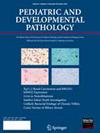内皮细胞糖萼降解标志物 Syndecan-1 的水平与胎儿绒毛膜羊膜炎相关,是早发新生儿败血症的潜在生物标志物
IF 1.3
4区 医学
Q3 PATHOLOGY
引用次数: 0
摘要
这项研究的目的是确定宫内绒毛膜羊膜炎(CA)早产新生儿血清中的Syndecan-1(S1)水平与S1作为早发新生儿败血症生物标志物的潜力之间的关联。研究人员招募了一批胎龄33周的早产新生儿。新生儿出生后 48 小时内,抽取 0.5 mL 血液,通过 ELISA 方法检测 S1 水平。对胎盘进行检查,并将其分为(1)无CA、(2)无脐带受累的CA或(3)伴有脐带炎症(真菌炎)的CA。比较了未接触过 CA 的早产新生儿与接触过 CA 的新生儿(包括患有和未患有真菌炎)的 S1 水平。结果发现,与未接触 CA 的早产儿相比,接触过 CA 的早产儿的 S1 水平明显升高。虽然S1水平无法区分胎儿是否接触过CA和是否接触过CA伴真菌炎,但与未接触过CA的新生儿相比,接触过CA的新生儿组的S1水平明显较高。S1水平有可能成为一种对临床有用的生物标志物,有助于管理患有CA和真菌炎的母亲和早产新生儿。此外,S1水平还有助于早期新生儿败血症的诊断和治疗。本文章由计算机程序翻译,如有差异,请以英文原文为准。
Syndecan-1 Level, a Marker of Endothelial Glycocalyx Degradation, Is Associated With Fetal Exposure to Chorioamnionitis and Is a Potential Biomarker for Early-Onset Neonatal Sepsis
The goal of this investigation was to identify the association between Syndecan-1 (S1) serum levels in preterm newborns exposed to chorioamnionitis (CA) in utero and the potential of S1 as a biomarker of early-onset neonatal sepsis. A cohort of preterm newborns born <33 weeks gestational age was recruited. Within 48 hours of birth, 0.5 mL of blood was drawn to obtain S1 levels, measured via ELISA. Placentas were examined and classified as having (1) no CA, (2) CA without umbilical cord involvement, or (3) CA with inflammation of the umbilical cord (funisitis). S1 levels were compared between preterm newborns without exposure to CA verus newborns with exposure to CA (including with and without funisitis). Preterm newborns exposed to CA were found to have significantly elevated S1 levels compared to those unexposed. Although S1 levels could not differentiate fetal exposure to CA from exposure to CA with funisitis, the combined CA groups had significantly higher S1 levels compared to those not exposed to CA. S1 level has the potential to become a clinically useful biomarker that could assist in the management of mothers and preterm newborns with CA and funisitis. Furthermore, S1 level could aid in the diagnosis and treatment of early-onset neonatal sepsis.
求助全文
通过发布文献求助,成功后即可免费获取论文全文。
去求助
来源期刊
CiteScore
3.70
自引率
5.30%
发文量
59
审稿时长
6-12 weeks
期刊介绍:
The Journal covers the spectrum of disorders of early development (including embryology, placentology, and teratology), gestational and perinatal diseases, and all diseases of childhood. Studies may be in any field of experimental, anatomic, or clinical pathology, including molecular pathology. Case reports are published only if they provide new insights into disease mechanisms or new information.

 求助内容:
求助内容: 应助结果提醒方式:
应助结果提醒方式:


